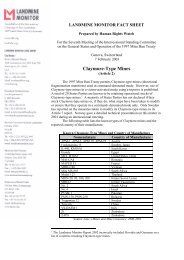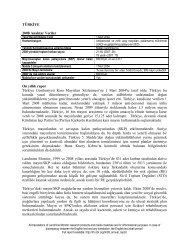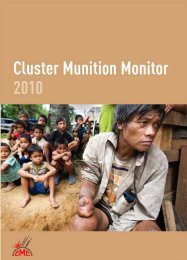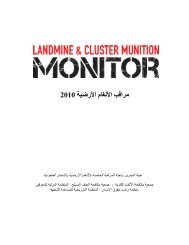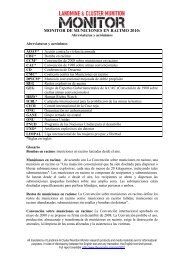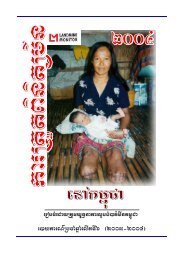Download PDF - Landmine and Cluster Munition Monitor
Download PDF - Landmine and Cluster Munition Monitor
Download PDF - Landmine and Cluster Munition Monitor
You also want an ePaper? Increase the reach of your titles
YUMPU automatically turns print PDFs into web optimized ePapers that Google loves.
Contamination <strong>and</strong> Clearance<br />
Clearance of cluster munition remnants in 2011<br />
State/area Area cleared (km 2 ) No. of submunitions destroyed<br />
Afghanistan 0 4,800*<br />
BiH 0 59<br />
Croatia 0.58 314<br />
Iraq** Not reported 3,596<br />
Lao PDR 40.85 31,302<br />
Lebanon 2.51 4,888<br />
Cambodia Not reported 57<br />
Libya Not reported 180<br />
Serbia 1.15 91<br />
Thail<strong>and</strong> 0.32 76<br />
Vietnam *** Not reported 3,798<br />
Kosovo Not reported Not reported<br />
Nagorno-Karabakh 8.5 500<br />
Western Sahara 1.05 3,148<br />
Total 54.96 52,845<br />
Note: Convention on <strong>Cluster</strong> <strong>Munition</strong> States Parties <strong>and</strong> signatories are indicated by bold <strong>and</strong> other areas by italics. * RONCO found<br />
200 ab<strong>and</strong>oned cluster munitions at Kabul International Airport in 2011. ** Incomplete data. *** Data from international NGOs only<br />
as no information on cluster munition clearance was provided by the Engineering Comm<strong>and</strong> of the Ministry of Defense<br />
In 2010, at least 59,978 unexploded submunitions were destroyed during clearance operations of some 18.5km 2 of l<strong>and</strong><br />
contaminated by cluster munitions in 18 states <strong>and</strong> three other areas. 65<br />
Clearance obligations<br />
Under the Convention on <strong>Cluster</strong> <strong>Munition</strong>s, each State Party is obliged to clear <strong>and</strong> destroy all cluster munition remnants<br />
in areas under its jurisdiction or control as soon as possible, but not later than 10 years after its ratification. If unable to<br />
complete clearance in time, a state may request an extension of the deadline for periods of up to five years. Clearance<br />
deadlines for contaminated States Parties are shown below.<br />
In seeking to fulfill their clearance <strong>and</strong> destruction<br />
obligations, affected States Parties are required to:<br />
• survey, assess, <strong>and</strong> record the threat, making every<br />
effort to identify all contaminated areas under their<br />
jurisdiction or control;<br />
• assess <strong>and</strong> prioritize needs for marking, protection of<br />
civilians, clearance, <strong>and</strong> destruction;<br />
• take “all feasible steps” to perimeter-mark, monitor, <strong>and</strong><br />
fence affected areas;<br />
• conduct risk reduction education to ensure awareness<br />
among civilians living in or around areas contaminated<br />
by cluster munitions;<br />
• take steps to mobilize the necessary resources (at<br />
national <strong>and</strong> international levels); <strong>and</strong><br />
• develop a national plan, building upon existing<br />
structures, experiences, <strong>and</strong> methodologies.<br />
Article 4 clearance deadlines for States Parties<br />
State Party Clearance deadline<br />
Aganistan 1 March 2022<br />
BiH 1 March 2021<br />
Chile 1 June 2021<br />
Croatia 1 August 2020<br />
Germany 1 August 2020<br />
Lao PDR 1 August 2020<br />
Lebanon 1 May 2021<br />
Mauritania 1 August 2022<br />
Montenegro 1 August 2020<br />
Norway 1 August 2020<br />
L<strong>and</strong> release<br />
During the first intersessional meetings of the convention in June 2011, the CMC published Guiding Principles for L<strong>and</strong><br />
Release of <strong>Cluster</strong> <strong>Munition</strong>-Affected Areas. According to the paper, a baseline assessment of the problem should be the<br />
first priority for affected States Parties, which are obliged to “make every effort” to identify cluster munition affected<br />
areas under their jurisdiction or control. A key lesson learned regarding implementation of the Mine Ban Treaty is that<br />
sufficient resources are needed to properly identify affected areas before clearance begins.<br />
65<br />
Afghanistan, Angola, BiH, Cambodia, Croatia, DRC, Guinea-Bissau, Iraq, Lao PDR, Lebanon, Montenegro, Mozambique, Palau, Serbia,<br />
Tajikistan, UK, Vietnam, <strong>and</strong> Zambia. The three other areas were Kosovo, Nagorno-Karabakh, <strong>and</strong> Western Sahara.<br />
47



